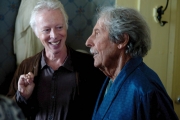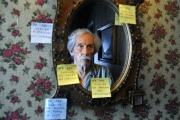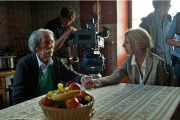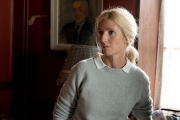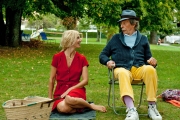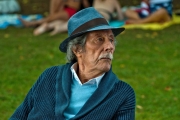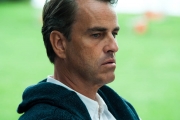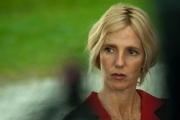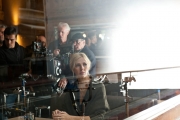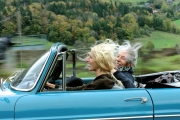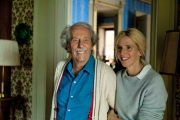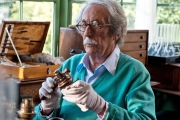![]() Presentation by and discussion with director and screenwriter Philippe Le Guay
Presentation by and discussion with director and screenwriter Philippe Le Guay
Claude Lherminier, 80, has never lost his panache. However, more and more he experiences moments of forgetfulness, fits of confusion . . . a condition he obstinately denies. Carole, his oldest daughter, constantly battles to keep him from his own devices. Suddenly, Claude decides to fly off to Florida. What is behind this unexpected journey?
Cast & Crew
Director • Philippe Le Guay
Screenwriters • Philippe Le Guay and Jérôme Tonnerre
Director of Photography • Jean-Claude Larrieu
Producers • Jean-Louis Livi and Philippe Carcassonne
Starring :
Jean Rochefort, Sandrine Kiberlain, Laurent Lucas, Anamaria Marinca…
Choose a picture to see the filmography (source : IMDB)
![]()
How did you develop the scenario with Jérôme Tonnerre?
I discovered Florian Zeller’s play Le Père on stage. It is the first time that I have adapted a pre-existing work. It was never envisioned to make a simple video recording of the play. Florian Zeller himself encouraged us to diverge from the original play. In filmmaking, subjectivity of the hero is immediately established by the use of the “shot reverse shot” technique. You simply have to film the character gazing at something, then the object of the gaze in order to install a point of view. Here, it was necessary for us to come up with another type of narration, and a setting that was different from the one in the play. We explored many possibilities, went in all directions, but it was Jérôme Tonnerre’s inspiration, to place the character in a plane, that gave the right impetus to the film. This voyage gave us a guideline, with respect to the trajectory of a movie. Nothing is more cinematographic than a character travelling from one place to another. This voyage is not imaginary, nor a dream, even if the narrative seems like a mental journey: we are actually inside a man’s head. Quickly, we can see that this man has a goal, an obsessive idea: to be reunited with his daughter who lives in Florida. It allowed us not to dwell on the “medical” aspect of the subject, the loss of memory symptoms. I would not call this film the story of a sick man. For me, this movie is the story of a man who is truly going to visit his daughter in Florida . . .
How did you decide to entrust the lead character to Jean Rochefort?
This role of the father is Shakespearian. But it also allows for fantasy and humor. Jean Rochefort is an accomplished actor who fully embodies these two characteristics. He has a freedom that we can see in the comedies of Yves Robert or Philippe De Broca, with those twinkling eyes and this malicious playfulness, and still there is a side of him that is somber, hardened, and even a little violent. Rochefort’s inherent and full theatrical nature allows for this mix of tones and genres.
On the technical level, how did you work with the lighting?
By our choices of scenery. With my director of photography Jean-Claude Larrieu, we wanted to compensate for the harshness of memory loss by creating a warm and glowing atmosphere. There are colors in every scene, whether through the presence of orange lightening or through the bright colors of the costumes. We frequently think of old age as being gray and colorless. In real life, Jean Rochefort wears a wide variety of colors and we emphasized that aspect. With Elisabeth Tavernier, who created the costumes, we had the image of David Hockney in mind, who is famous for his vivid outfits. Incidentally, we replicated the English painter’s glasses for Jean…
And the music?
I love the two-dimensional music of Jorge Arriagada, at the same time joyous and melancholic. I am sensitive to melodies that you want to keep singing even after you leave the room. The music has to be an emotional extension of the character, without accentuating his confused mental state.
Jean Rochefort sings a song by Jean Sablon titled “Puisque vous partez en voyage”. . .
I realized that this song echoed the theme of the journey to Florida. We came up with this choice of destination almost by chance, but little by little, it got exemplified in many ways. There is the French car, called a Floride; the orange juice, Miami, the palm trees… Florida became this mythical place where you feel protected, where nothing can harm you. It is a place of appeasement, where all that has taken a toll on you ceases to hurt. Actually, Florida is a bit like the inside of a cinema, at the same time a screen and a protective case where one can dream, where loved ones are with us forever . . .
Press Kit “Florida”
French ~ 14 pages ~ 7,2 Mo ~ pdf



